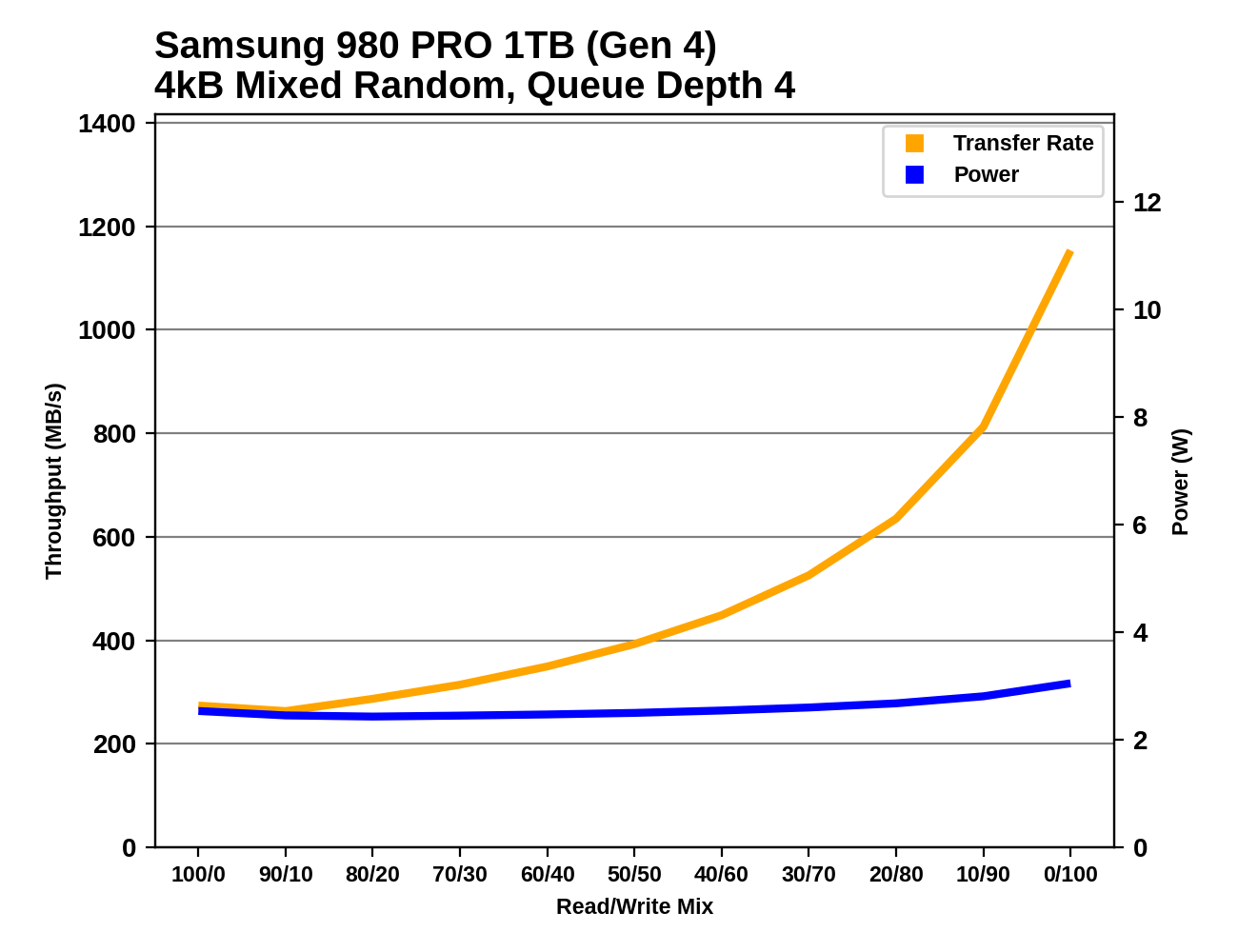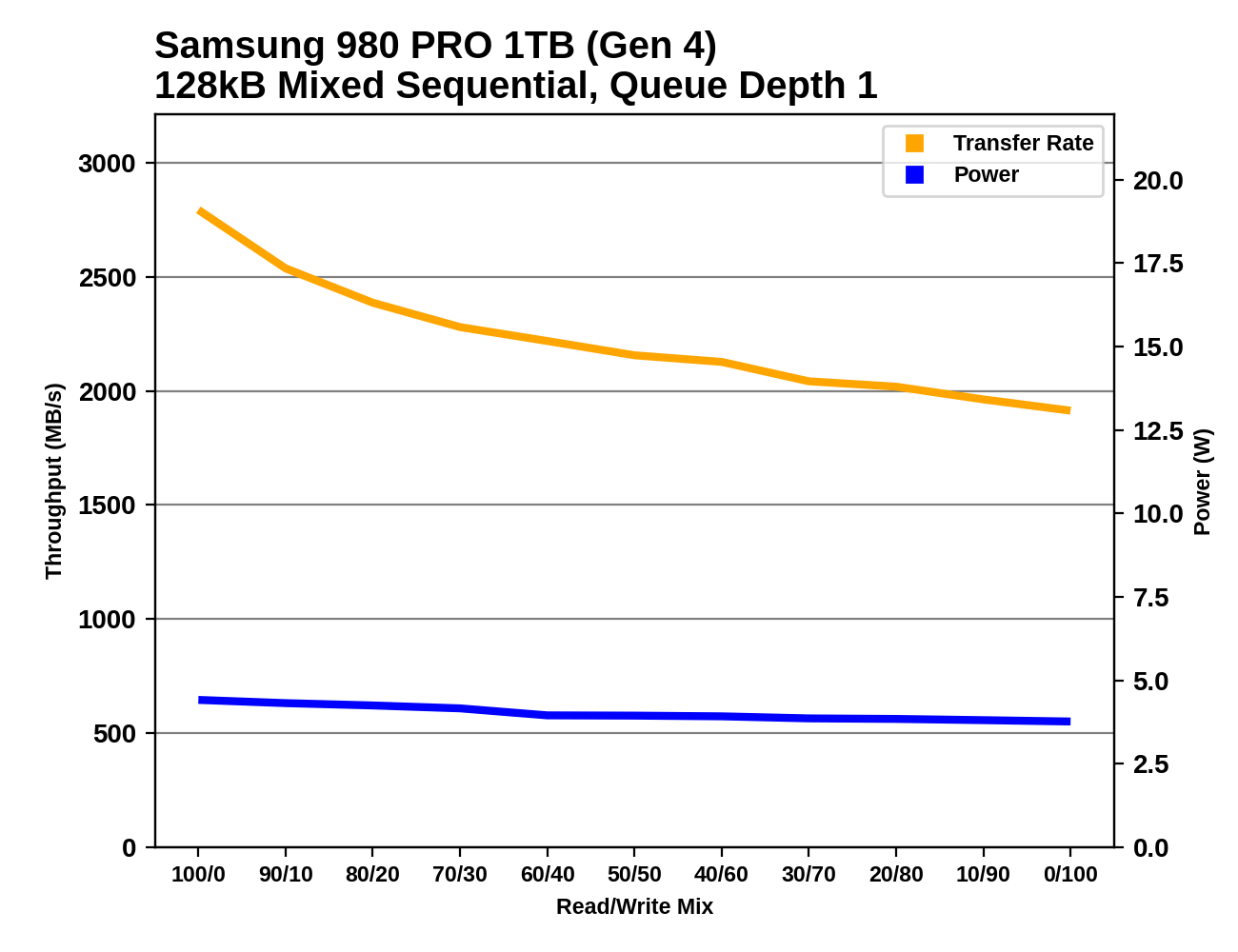The Samsung 980 PRO PCIe 4.0 SSD Review: A Spirit of Hope
by Billy Tallis on September 22, 2020 11:20 AM ESTNote: All our previous testing has been on an Intel test bed. Because of the move to PCIe 4.0, we have upgraded to Ryzen. Devices tested under Ryzen in time for this review are identified in the charts.
Mixed Random Performance
Our test of mixed random reads and writes covers mixes varying from pure reads to pure writes at 10% increments. Each mix is tested for up to 1 minute or 32GB of data transferred. The test is conducted with a queue depth of 4, and is limited to a 64GB span of the drive. In between each mix, the drive is given idle time of up to one minute so that the overall duty cycle is 50%.

Since our mixed random IO test uses a moderate queue depth of 4, the PCIe Gen4 drives don't get much chance to flex their muscle. The overall scores are still generally bound by NAND flash latency, which doesn't vary too widely between current generation drives. There's also a small performance boost when running this test on our newer, faster Ryzen testbed. The Samsung 980 PRO is clearly an improvement over its predecessors, but is merely tied for first place among flash-based drives with the SK hynix Gold P31.
 |
|||||||||
| Power Efficiency in MB/s/W | Average Power in W | ||||||||
Both capacities of the 980 PRO turn in good efficiency scores for the mixed random IO test, substantially improving on Samsung's previously mediocre standing. The 1TB 980 PRO's efficiency is second only to the SK hynix Gold P31. The 980 PROs are a bit more efficient running at PCIe Gen3 speeds than on the Gen4 platform, despite the ~10% performance boost on the faster system.
 |
|||||||||
There are no real surprises in the performance profiles of the 980 PROs. Both capacities show the same general behavior as earlier Samsung drives, albeit with small improvements to performance and power consumption across the board.
Mixed Sequential Performance
Our test of mixed sequential reads and writes differs from the mixed random I/O test by performing 128kB sequential accesses rather than 4kB accesses at random locations, and the sequential test is conducted at queue depth 1. The range of mixes tested is the same, and the timing and limits on data transfers are also the same as above.

The Samsung 980 PROs take the top spots for our mixed sequential IO test, with even the 250GB 980 PRO edging out the 1TB Seagate FireCuda 520. Even when limited to PCIe Gen3, the 980s are a clear step up in performance from eariler high-end drives. The improvement for the 250GB model is the most impressive, since the 250GB 970 EVO Plus is significantly slower than most of the 1TB drives.
 |
|||||||||
| Power Efficiency in MB/s/W | Average Power in W | ||||||||
The 980 PROs turn in more good power efficiency numbers that place them clearly ahead of everything other than the SK hynix Gold P31. And this time, the P31's efficiency lead relatively small at no more than about 25%.
 |
|||||||||
The 980 PROs show a drastically different performance profile compared to earlier Samsung drives. The 970s tend to bottom out during the write-heavy half of the test and recover some performance toward the end. Now with the 980 PRO, performance in the write-heavy half doesn't drop precipitously, so we see a steady decline that most closely resembles how the Intel Optane SSD handles this test










137 Comments
View All Comments
msroadkill612 - Tuesday, October 13, 2020 - link
Yep. I find the raw sequential speeds exciting too - its not just about IOPS :)This processor load balancing coincides w/ some very handy advances in mainstream system memory - typically? 64GB (2x 32GB 3200 cl16 ~$220 atm) w/ speeds to ~45-50GB/s on AM4?,
a PCIE 4 GPU w/ a 32GB/s link vs the former 16GB/s. Its little mentioned, but seems an important plateau - ~64GB at 32GB/s seems a pretty usable supplemental tier of cache for the gpu?
quite possibly, nvme ports on the GPU's Infinity Fabric bus on ~BigNavi to bypass a potentially bottlenecked pcie bus - AMD did it before with a pro Vega card - an nvme raid array on the gpu.
individually they are increments in currently usable gaming memory & bandwidth (if not IOPS), but collectively they could be a force which affects gaming?
Games are what they are due to the restrictions of yore. Of course they are coded to isolate within gpu resources.. it was the only way to run fast enough. Reduce the restrictions tho, & add new usable resources, & games change to provide new & richer experiences.
MS FS is perhaps a forerunner of this new mindset - it likes massive memory, but is fun at 30FPS.
crabperson - Tuesday, September 22, 2020 - link
Thanks for the comparison to the PM1725a, I didn't realize how the lack of an SLC cache hurt it so much! I got a used 3.2 TB 'b version for a song, still holding out on Haswell here and probably won't upgrade until next year (Zen 3 may convince me otherwise).Looking forward to Phison's updated controllers and 2TB+ drives next year. Definitely don't need to waste money on the Pro line anymore.
Billy Tallis - Tuesday, September 22, 2020 - link
I was actually surprised how poorly the PM1725a fared on the consumer tests. I knew that the lack of SLC caching would hurt its writes, but it also appears to be heavily optimized for high queue depths at the expense of low queue depth performance.I'm planning to have some overlap between the enterprise and consumer synthetic benchmarks going forward, so there should be more opportunities to notice stuff like this.
ZeDestructor - Tuesday, September 22, 2020 - link
Any particular reson for not running the 3 desktop loads as well? I'm curious how the drives perform in more "real-world" desktop workloads tooBilly Tallis - Tuesday, September 22, 2020 - link
Time constraints, mostly. I grabbed the PM1725a because of its potential to show similar peak throughput, and it takes less than two hours to run the synthetic tests. A full set of ATSB results is a minimum of 12 hours plus however long it takes to fill the drive twice.ZeDestructor - Wednesday, September 23, 2020 - link
Couldn't you do it during downtime and then lump the results directly into bench? I'm not particularly fussed about having the results in this particular review, but they would be very nice to have around eventually™ for weirdos like me who buy used server drives for cheap and stick em into the desktop.PopinFRESH007 - Tuesday, September 22, 2020 - link
The Rocket 4 Plus was already announced and should be shipping this year with what looks to be better performance than this. Will be interesting to see what the price will be. The E18 also supports NVMe 1.4 rather than 1.3c on the 980 Pro.ToTTenTranz - Tuesday, September 22, 2020 - link
So.. is this a SSD that can go into the PS5 as expandable storage?Billy Tallis - Tuesday, September 22, 2020 - link
Probably. Sony hasn't put out their list of officially approved/tested SSDs yet, but this one should qualify and then some.UltraWide - Tuesday, September 22, 2020 - link
The RANDOM R/W scores are average. It looks like the SK Hynix is a better SSD for real world use.